Detailed Report: Principles of Office Administration and Management
VerifiedAdded on 2020/06/06
|12
|3383
|89
Report
AI Summary
This report delves into the multifaceted principles of office administration, encompassing a wide array of topics crucial for effective management. It begins by outlining legal requirements pertinent to office facilities, detailing typical services provided and establishing procedures for efficient office management. The report then explores managing office resources, monitoring workflows, and ensuring workplace safety, including legal obligations and emergency procedures. It further examines meeting management, covering minute-taking, types of meetings, and facilitation techniques. The report also addresses workload management through targets and budgets, allocation of work, and quality management techniques. Finally, it explores event planning, including event characteristics, resource identification, and information requirements for delegates. The report provides insights into the importance of accuracy in minute taking, the roles and responsibilities of meeting participants, and techniques for improvements in team outputs and standards. The report references various sources to support its findings, providing a comprehensive overview of the principles and practices of office administration.
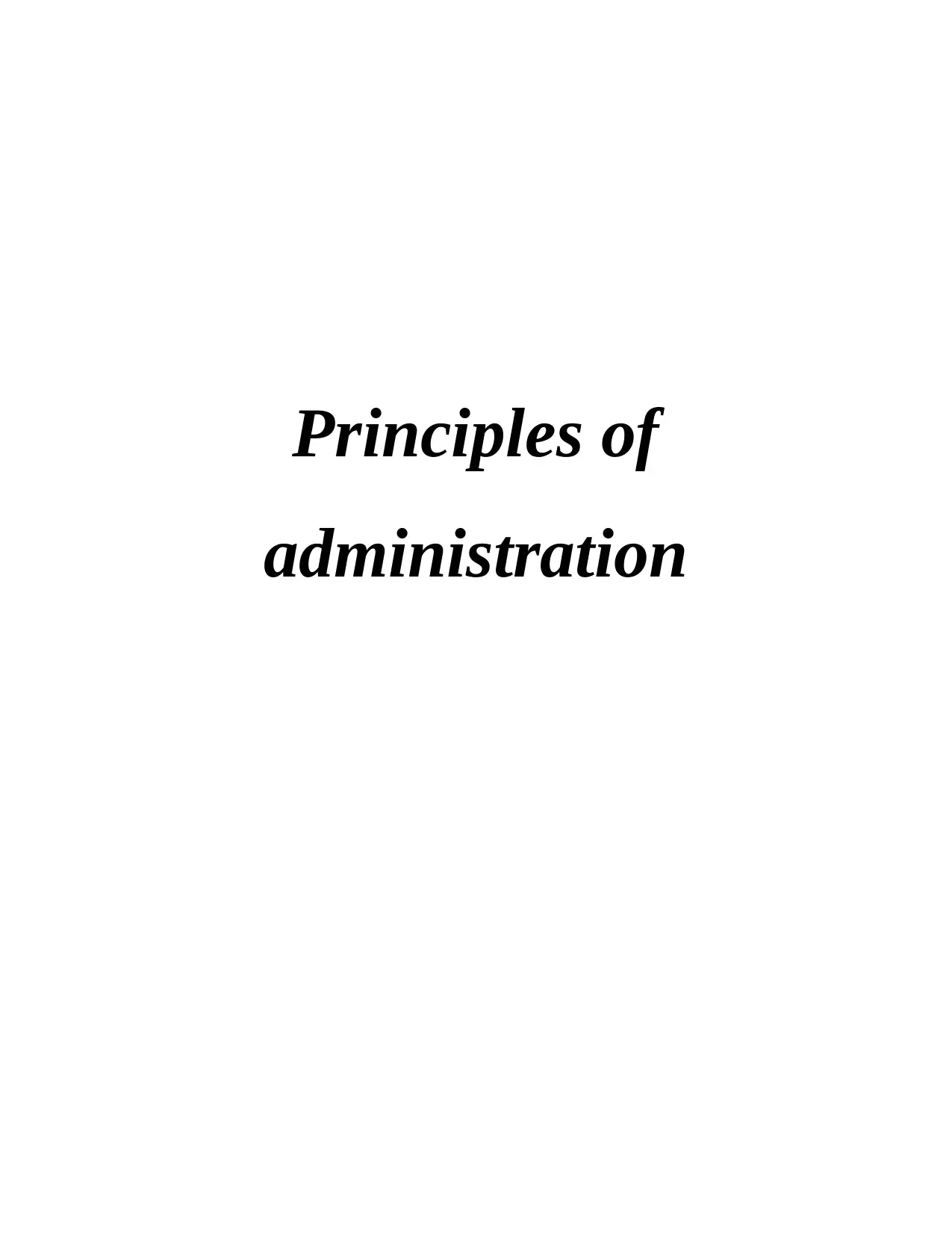
Principles of
administration
administration
Paraphrase This Document
Need a fresh take? Get an instant paraphrase of this document with our AI Paraphraser
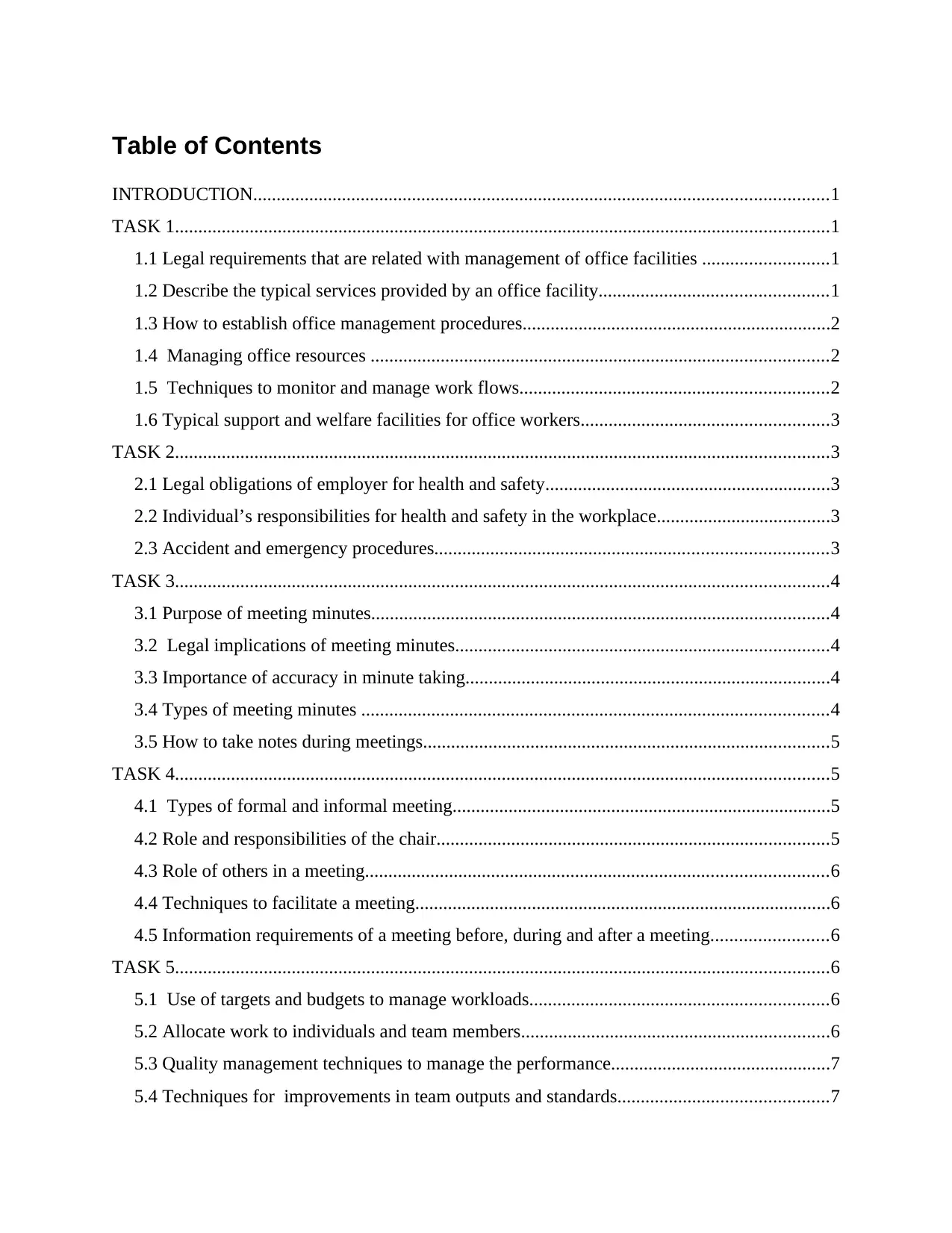
Table of Contents
INTRODUCTION...........................................................................................................................1
TASK 1............................................................................................................................................1
1.1 Legal requirements that are related with management of office facilities ...........................1
1.2 Describe the typical services provided by an office facility.................................................1
1.3 How to establish office management procedures..................................................................2
1.4 Managing office resources ..................................................................................................2
1.5 Techniques to monitor and manage work flows..................................................................2
1.6 Typical support and welfare facilities for office workers.....................................................3
TASK 2............................................................................................................................................3
2.1 Legal obligations of employer for health and safety.............................................................3
2.2 Individual’s responsibilities for health and safety in the workplace.....................................3
2.3 Accident and emergency procedures....................................................................................3
TASK 3............................................................................................................................................4
3.1 Purpose of meeting minutes..................................................................................................4
3.2 Legal implications of meeting minutes................................................................................4
3.3 Importance of accuracy in minute taking..............................................................................4
3.4 Types of meeting minutes ....................................................................................................4
3.5 How to take notes during meetings.......................................................................................5
TASK 4............................................................................................................................................5
4.1 Types of formal and informal meeting.................................................................................5
4.2 Role and responsibilities of the chair....................................................................................5
4.3 Role of others in a meeting...................................................................................................6
4.4 Techniques to facilitate a meeting.........................................................................................6
4.5 Information requirements of a meeting before, during and after a meeting.........................6
TASK 5............................................................................................................................................6
5.1 Use of targets and budgets to manage workloads................................................................6
5.2 Allocate work to individuals and team members..................................................................6
5.3 Quality management techniques to manage the performance...............................................7
5.4 Techniques for improvements in team outputs and standards.............................................7
INTRODUCTION...........................................................................................................................1
TASK 1............................................................................................................................................1
1.1 Legal requirements that are related with management of office facilities ...........................1
1.2 Describe the typical services provided by an office facility.................................................1
1.3 How to establish office management procedures..................................................................2
1.4 Managing office resources ..................................................................................................2
1.5 Techniques to monitor and manage work flows..................................................................2
1.6 Typical support and welfare facilities for office workers.....................................................3
TASK 2............................................................................................................................................3
2.1 Legal obligations of employer for health and safety.............................................................3
2.2 Individual’s responsibilities for health and safety in the workplace.....................................3
2.3 Accident and emergency procedures....................................................................................3
TASK 3............................................................................................................................................4
3.1 Purpose of meeting minutes..................................................................................................4
3.2 Legal implications of meeting minutes................................................................................4
3.3 Importance of accuracy in minute taking..............................................................................4
3.4 Types of meeting minutes ....................................................................................................4
3.5 How to take notes during meetings.......................................................................................5
TASK 4............................................................................................................................................5
4.1 Types of formal and informal meeting.................................................................................5
4.2 Role and responsibilities of the chair....................................................................................5
4.3 Role of others in a meeting...................................................................................................6
4.4 Techniques to facilitate a meeting.........................................................................................6
4.5 Information requirements of a meeting before, during and after a meeting.........................6
TASK 5............................................................................................................................................6
5.1 Use of targets and budgets to manage workloads................................................................6
5.2 Allocate work to individuals and team members..................................................................6
5.3 Quality management techniques to manage the performance...............................................7
5.4 Techniques for improvements in team outputs and standards.............................................7
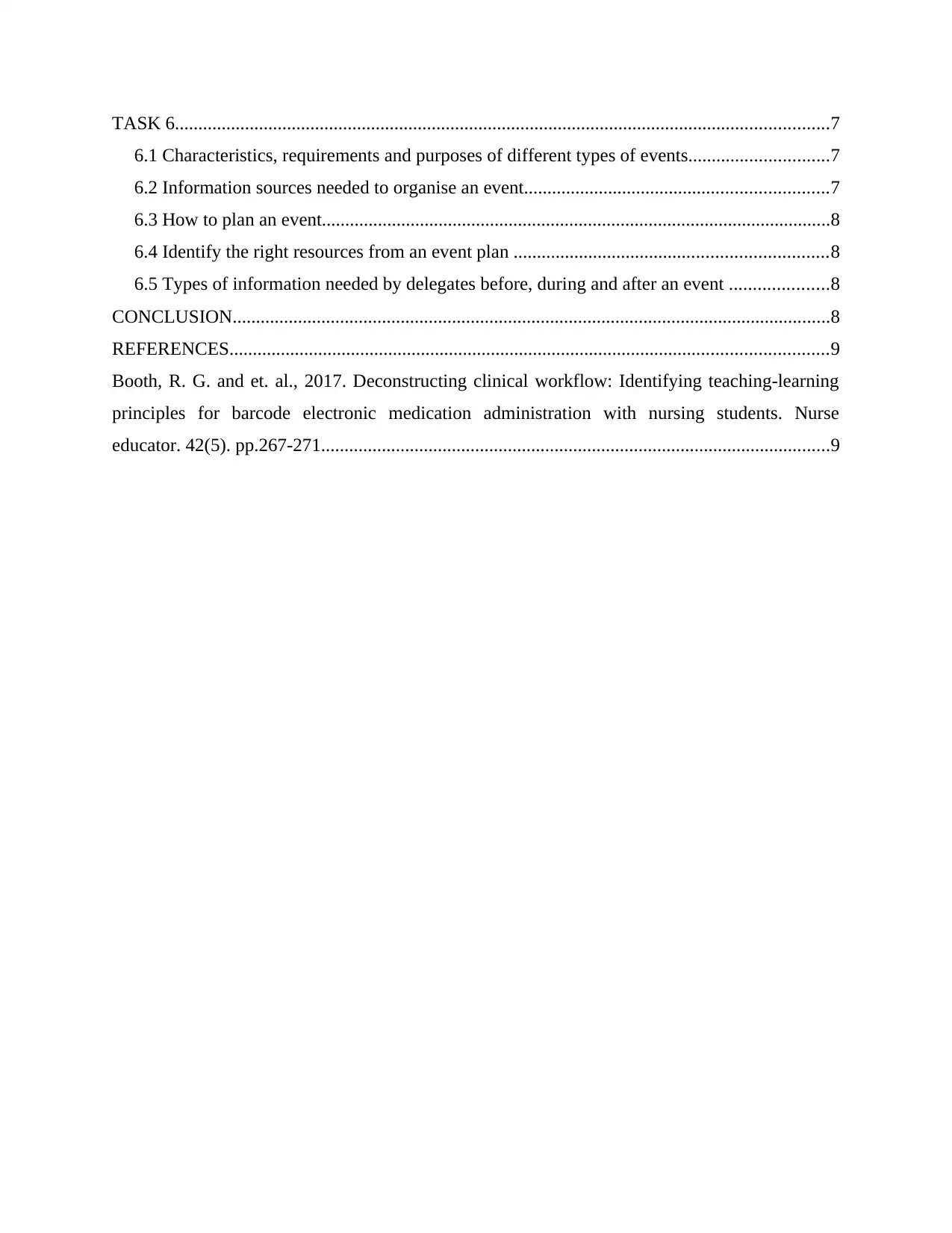
TASK 6............................................................................................................................................7
6.1 Characteristics, requirements and purposes of different types of events..............................7
6.2 Information sources needed to organise an event.................................................................7
6.3 How to plan an event.............................................................................................................8
6.4 Identify the right resources from an event plan ...................................................................8
6.5 Types of information needed by delegates before, during and after an event .....................8
CONCLUSION................................................................................................................................8
REFERENCES................................................................................................................................9
Booth, R. G. and et. al., 2017. Deconstructing clinical workflow: Identifying teaching-learning
principles for barcode electronic medication administration with nursing students. Nurse
educator. 42(5). pp.267-271.............................................................................................................9
6.1 Characteristics, requirements and purposes of different types of events..............................7
6.2 Information sources needed to organise an event.................................................................7
6.3 How to plan an event.............................................................................................................8
6.4 Identify the right resources from an event plan ...................................................................8
6.5 Types of information needed by delegates before, during and after an event .....................8
CONCLUSION................................................................................................................................8
REFERENCES................................................................................................................................9
Booth, R. G. and et. al., 2017. Deconstructing clinical workflow: Identifying teaching-learning
principles for barcode electronic medication administration with nursing students. Nurse
educator. 42(5). pp.267-271.............................................................................................................9
⊘ This is a preview!⊘
Do you want full access?
Subscribe today to unlock all pages.

Trusted by 1+ million students worldwide
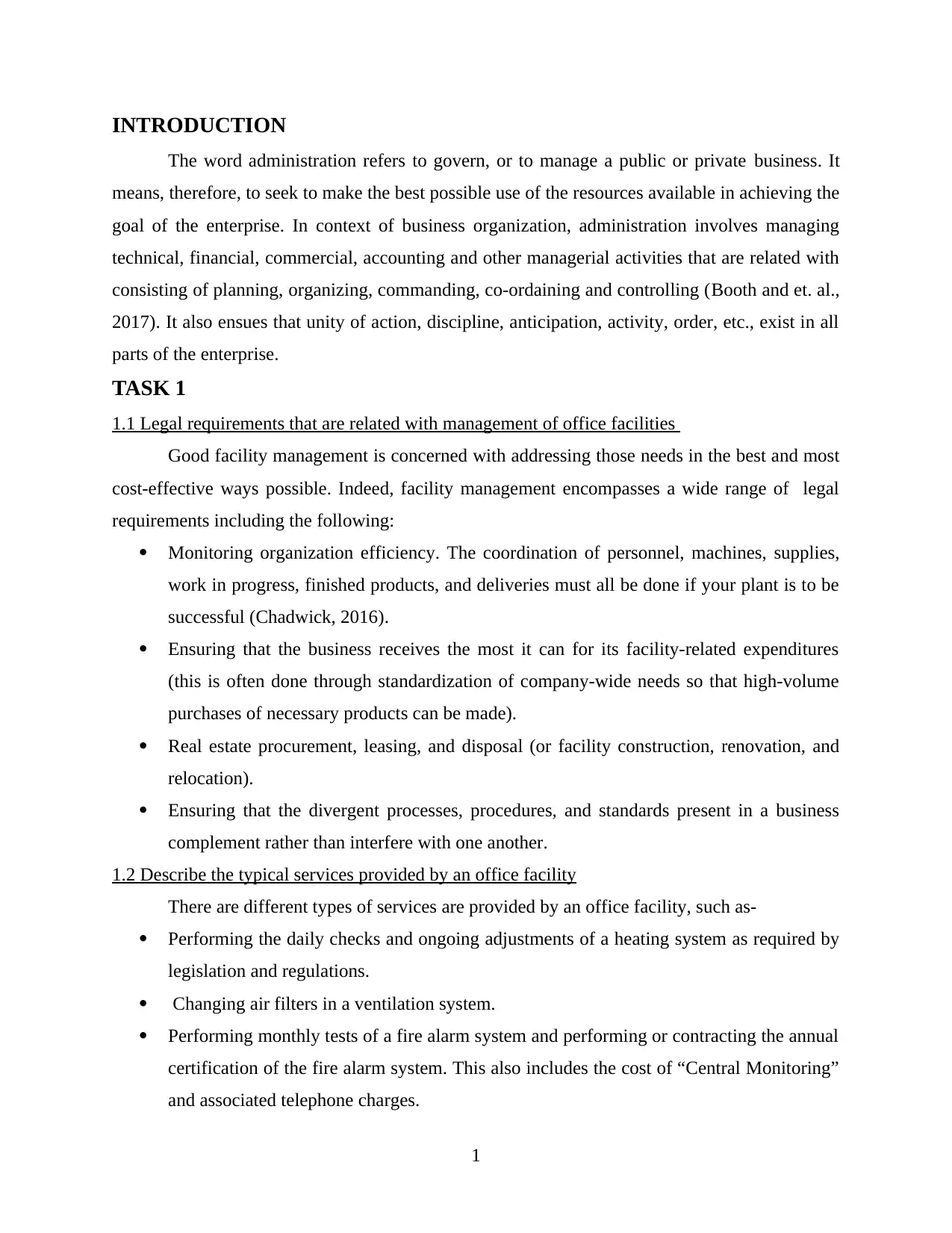
INTRODUCTION
The word administration refers to govern, or to manage a public or private business. It
means, therefore, to seek to make the best possible use of the resources available in achieving the
goal of the enterprise. In context of business organization, administration involves managing
technical, financial, commercial, accounting and other managerial activities that are related with
consisting of planning, organizing, commanding, co-ordaining and controlling (Booth and et. al.,
2017). It also ensues that unity of action, discipline, anticipation, activity, order, etc., exist in all
parts of the enterprise.
TASK 1
1.1 Legal requirements that are related with management of office facilities
Good facility management is concerned with addressing those needs in the best and most
cost-effective ways possible. Indeed, facility management encompasses a wide range of legal
requirements including the following:
Monitoring organization efficiency. The coordination of personnel, machines, supplies,
work in progress, finished products, and deliveries must all be done if your plant is to be
successful (Chadwick, 2016).
Ensuring that the business receives the most it can for its facility-related expenditures
(this is often done through standardization of company-wide needs so that high-volume
purchases of necessary products can be made).
Real estate procurement, leasing, and disposal (or facility construction, renovation, and
relocation).
Ensuring that the divergent processes, procedures, and standards present in a business
complement rather than interfere with one another.
1.2 Describe the typical services provided by an office facility
There are different types of services are provided by an office facility, such as-
Performing the daily checks and ongoing adjustments of a heating system as required by
legislation and regulations.
Changing air filters in a ventilation system.
Performing monthly tests of a fire alarm system and performing or contracting the annual
certification of the fire alarm system. This also includes the cost of “Central Monitoring”
and associated telephone charges.
1
The word administration refers to govern, or to manage a public or private business. It
means, therefore, to seek to make the best possible use of the resources available in achieving the
goal of the enterprise. In context of business organization, administration involves managing
technical, financial, commercial, accounting and other managerial activities that are related with
consisting of planning, organizing, commanding, co-ordaining and controlling (Booth and et. al.,
2017). It also ensues that unity of action, discipline, anticipation, activity, order, etc., exist in all
parts of the enterprise.
TASK 1
1.1 Legal requirements that are related with management of office facilities
Good facility management is concerned with addressing those needs in the best and most
cost-effective ways possible. Indeed, facility management encompasses a wide range of legal
requirements including the following:
Monitoring organization efficiency. The coordination of personnel, machines, supplies,
work in progress, finished products, and deliveries must all be done if your plant is to be
successful (Chadwick, 2016).
Ensuring that the business receives the most it can for its facility-related expenditures
(this is often done through standardization of company-wide needs so that high-volume
purchases of necessary products can be made).
Real estate procurement, leasing, and disposal (or facility construction, renovation, and
relocation).
Ensuring that the divergent processes, procedures, and standards present in a business
complement rather than interfere with one another.
1.2 Describe the typical services provided by an office facility
There are different types of services are provided by an office facility, such as-
Performing the daily checks and ongoing adjustments of a heating system as required by
legislation and regulations.
Changing air filters in a ventilation system.
Performing monthly tests of a fire alarm system and performing or contracting the annual
certification of the fire alarm system. This also includes the cost of “Central Monitoring”
and associated telephone charges.
1
Paraphrase This Document
Need a fresh take? Get an instant paraphrase of this document with our AI Paraphraser

Replacing a defective heat detector on a fire alarm system. • Responding to mechanical
alarms.
Repairing a damaged door, window or the hardware on this type of component.
1.3 How to establish office management procedures
Work Safety and Security: Each employee needs to know the location of the emergency
exits, first-aid kits, fire extinguishers and other safety tools as well as evacuation procedures.
Supply Ordering: Each employee should have complete information on your standard
suppliers for various needs at the company and familiarity with the process of generating
purchase orders (Enriquez-Navas and et. al., 2016).
1.4 Managing office resources
The most efficient way to manage resource use in your office is to take a systematic
approach:
Set a baseline to work out your current performance
Benchmark your performance against similar organisations
Create an action plan to achieve your identified improvements
Set achievable targets and responsibilities for office staff to meet them
Monitor and report your performance and set up reporting processes
Review actions and performance to learn lessons and continually improve
1.5 Techniques to monitor and manage work flows
Clean up your clutter - A messy office makes important documents harder to find, and
can lead to misplaced files and missed deadlines as work goes unseen in the mess. Try enforcing
a clean-desk policy and keeping communal workspaces clutter-free.
Measure productivity - It’s all very well following advice to improve productivity, but
if managers don't have any data against which to measure improvements they won’t know what’s
working for organisation and what isn’t.
1.6 Typical support and welfare facilities for office workers
Cleanliness and waste disposal - Cleaning work and disposal of waste should be carried
out routinely in order to maintain good standards of cleanliness and hygiene in the workplace
(Hermann, Pentek and Otto, 2016).
2
alarms.
Repairing a damaged door, window or the hardware on this type of component.
1.3 How to establish office management procedures
Work Safety and Security: Each employee needs to know the location of the emergency
exits, first-aid kits, fire extinguishers and other safety tools as well as evacuation procedures.
Supply Ordering: Each employee should have complete information on your standard
suppliers for various needs at the company and familiarity with the process of generating
purchase orders (Enriquez-Navas and et. al., 2016).
1.4 Managing office resources
The most efficient way to manage resource use in your office is to take a systematic
approach:
Set a baseline to work out your current performance
Benchmark your performance against similar organisations
Create an action plan to achieve your identified improvements
Set achievable targets and responsibilities for office staff to meet them
Monitor and report your performance and set up reporting processes
Review actions and performance to learn lessons and continually improve
1.5 Techniques to monitor and manage work flows
Clean up your clutter - A messy office makes important documents harder to find, and
can lead to misplaced files and missed deadlines as work goes unseen in the mess. Try enforcing
a clean-desk policy and keeping communal workspaces clutter-free.
Measure productivity - It’s all very well following advice to improve productivity, but
if managers don't have any data against which to measure improvements they won’t know what’s
working for organisation and what isn’t.
1.6 Typical support and welfare facilities for office workers
Cleanliness and waste disposal - Cleaning work and disposal of waste should be carried
out routinely in order to maintain good standards of cleanliness and hygiene in the workplace
(Hermann, Pentek and Otto, 2016).
2

Room dimensions and space - Workrooms should provide enough free space to allow
people to freely access work areas and move within the workplace, free from the risk of tripping
or striking objects, etc. Where space is limited, careful planning should be considered.
TASK 2
2.1 Legal obligations of employer for health and safety
It is the duty of the employer to follow all legal laws and regulations such are stated as
under: -
Reporting of Injuries, Disease and Dangerous Occurrences Regulations (RIDDOR) 1992
The Control of Substances Hazardous to Health 1999 (COSHH)
The Management of Health and Safety at Work Regulations 1999
Workplace (Health, Safety and Welfare) Regulations 1992
The Health and Safety (Display Screen Equipment) Regulations 1992
The Provision and Use of Work Equipment Regulations 1998 (PUWER)
Electricity at Work Regulations
2.2 Individual’s responsibilities for health and safety in the workplace
Employees responsibilities for health and safety: -
As far as possible, to have any risks to your health and safety properly controlled
To be provided with any personal protective and safety equipment free of charge
To stop work and leave your work area, without being disciplined if you have reasonable
concerns about your safety.
To have rest breaks during the working day
To have time off from work during the working week
2.3 Accident and emergency procedures
Consider what might happen and how the alarm will be raised. Don’t forget night and
shift working, weekends and times when the premises are closed, eg holidays.
Plan what to do, including how to call the emergency services. Help them by clearly
marking your premises from the road. Consider drawing up a simple plan showing the
location of hazardous items.
Plan essential actions such as emergency plant shutdown, isolation or making processes
safe. Clearly identify important items like shut-off valves and electrical isolators etc
3
people to freely access work areas and move within the workplace, free from the risk of tripping
or striking objects, etc. Where space is limited, careful planning should be considered.
TASK 2
2.1 Legal obligations of employer for health and safety
It is the duty of the employer to follow all legal laws and regulations such are stated as
under: -
Reporting of Injuries, Disease and Dangerous Occurrences Regulations (RIDDOR) 1992
The Control of Substances Hazardous to Health 1999 (COSHH)
The Management of Health and Safety at Work Regulations 1999
Workplace (Health, Safety and Welfare) Regulations 1992
The Health and Safety (Display Screen Equipment) Regulations 1992
The Provision and Use of Work Equipment Regulations 1998 (PUWER)
Electricity at Work Regulations
2.2 Individual’s responsibilities for health and safety in the workplace
Employees responsibilities for health and safety: -
As far as possible, to have any risks to your health and safety properly controlled
To be provided with any personal protective and safety equipment free of charge
To stop work and leave your work area, without being disciplined if you have reasonable
concerns about your safety.
To have rest breaks during the working day
To have time off from work during the working week
2.3 Accident and emergency procedures
Consider what might happen and how the alarm will be raised. Don’t forget night and
shift working, weekends and times when the premises are closed, eg holidays.
Plan what to do, including how to call the emergency services. Help them by clearly
marking your premises from the road. Consider drawing up a simple plan showing the
location of hazardous items.
Plan essential actions such as emergency plant shutdown, isolation or making processes
safe. Clearly identify important items like shut-off valves and electrical isolators etc
3
⊘ This is a preview!⊘
Do you want full access?
Subscribe today to unlock all pages.

Trusted by 1+ million students worldwide
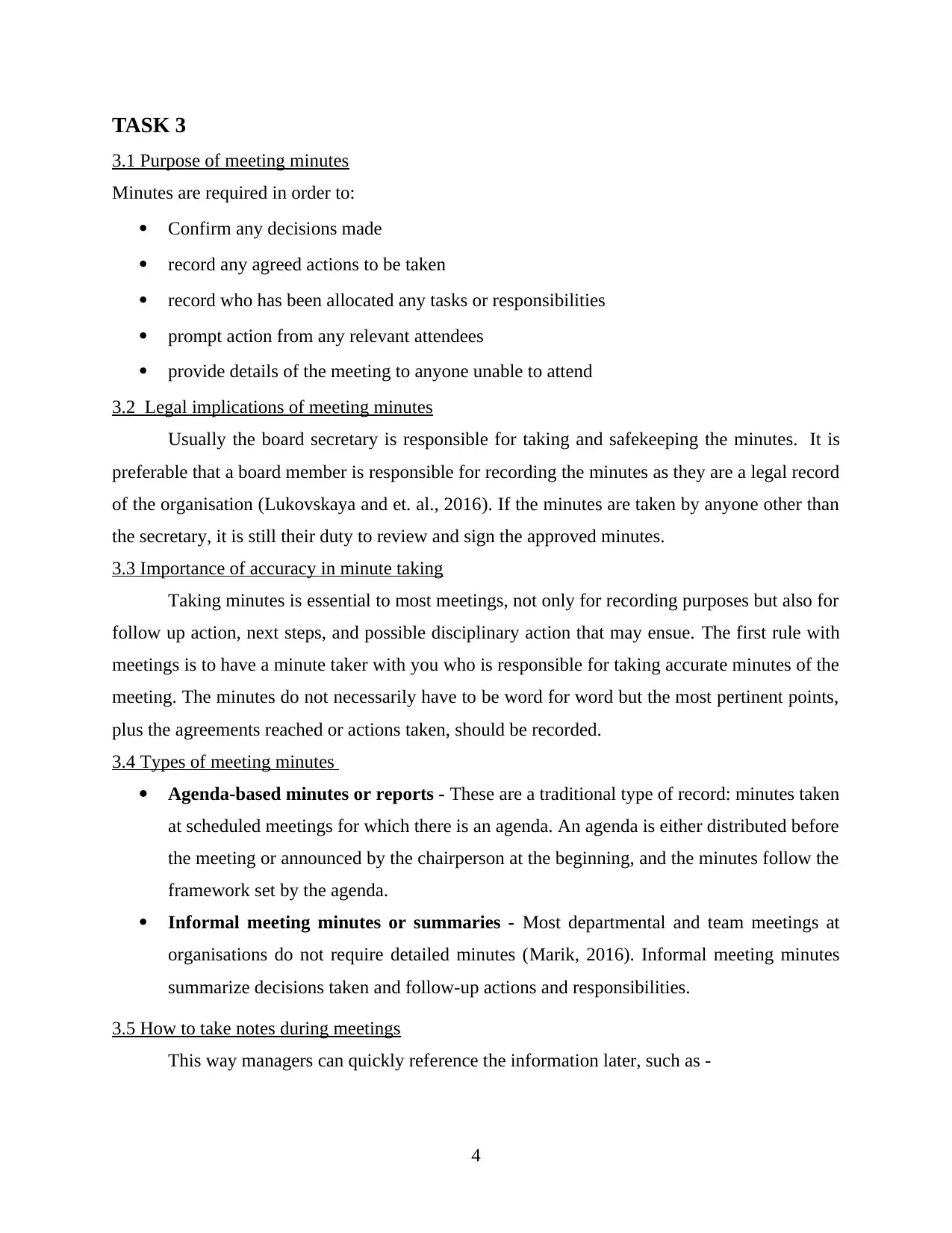
TASK 3
3.1 Purpose of meeting minutes
Minutes are required in order to:
Confirm any decisions made
record any agreed actions to be taken
record who has been allocated any tasks or responsibilities
prompt action from any relevant attendees
provide details of the meeting to anyone unable to attend
3.2 Legal implications of meeting minutes
Usually the board secretary is responsible for taking and safekeeping the minutes. It is
preferable that a board member is responsible for recording the minutes as they are a legal record
of the organisation (Lukovskaya and et. al., 2016). If the minutes are taken by anyone other than
the secretary, it is still their duty to review and sign the approved minutes.
3.3 Importance of accuracy in minute taking
Taking minutes is essential to most meetings, not only for recording purposes but also for
follow up action, next steps, and possible disciplinary action that may ensue. The first rule with
meetings is to have a minute taker with you who is responsible for taking accurate minutes of the
meeting. The minutes do not necessarily have to be word for word but the most pertinent points,
plus the agreements reached or actions taken, should be recorded.
3.4 Types of meeting minutes
Agenda-based minutes or reports - These are a traditional type of record: minutes taken
at scheduled meetings for which there is an agenda. An agenda is either distributed before
the meeting or announced by the chairperson at the beginning, and the minutes follow the
framework set by the agenda.
Informal meeting minutes or summaries - Most departmental and team meetings at
organisations do not require detailed minutes (Marik, 2016). Informal meeting minutes
summarize decisions taken and follow-up actions and responsibilities.
3.5 How to take notes during meetings
This way managers can quickly reference the information later, such as -
4
3.1 Purpose of meeting minutes
Minutes are required in order to:
Confirm any decisions made
record any agreed actions to be taken
record who has been allocated any tasks or responsibilities
prompt action from any relevant attendees
provide details of the meeting to anyone unable to attend
3.2 Legal implications of meeting minutes
Usually the board secretary is responsible for taking and safekeeping the minutes. It is
preferable that a board member is responsible for recording the minutes as they are a legal record
of the organisation (Lukovskaya and et. al., 2016). If the minutes are taken by anyone other than
the secretary, it is still their duty to review and sign the approved minutes.
3.3 Importance of accuracy in minute taking
Taking minutes is essential to most meetings, not only for recording purposes but also for
follow up action, next steps, and possible disciplinary action that may ensue. The first rule with
meetings is to have a minute taker with you who is responsible for taking accurate minutes of the
meeting. The minutes do not necessarily have to be word for word but the most pertinent points,
plus the agreements reached or actions taken, should be recorded.
3.4 Types of meeting minutes
Agenda-based minutes or reports - These are a traditional type of record: minutes taken
at scheduled meetings for which there is an agenda. An agenda is either distributed before
the meeting or announced by the chairperson at the beginning, and the minutes follow the
framework set by the agenda.
Informal meeting minutes or summaries - Most departmental and team meetings at
organisations do not require detailed minutes (Marik, 2016). Informal meeting minutes
summarize decisions taken and follow-up actions and responsibilities.
3.5 How to take notes during meetings
This way managers can quickly reference the information later, such as -
4
Paraphrase This Document
Need a fresh take? Get an instant paraphrase of this document with our AI Paraphraser
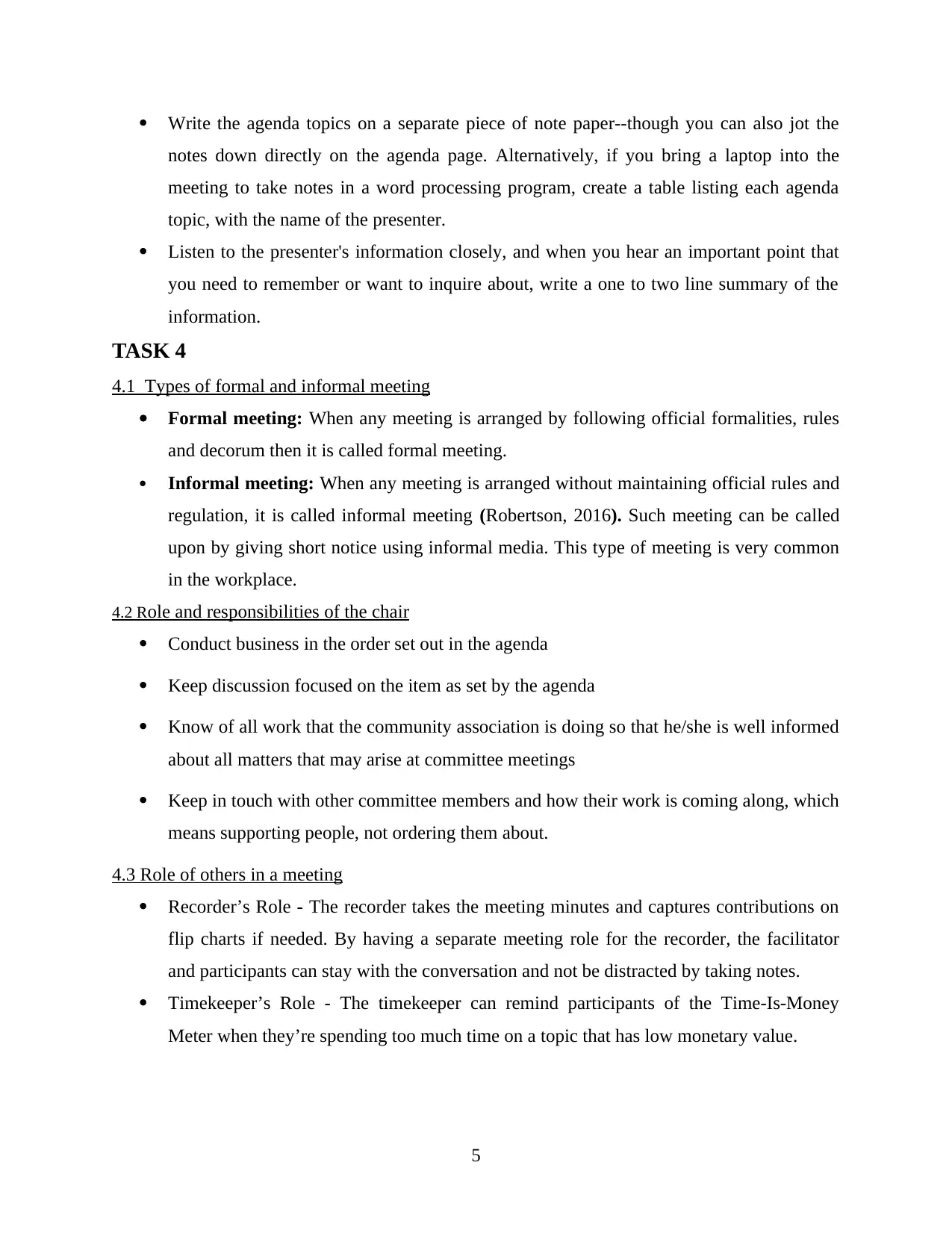
Write the agenda topics on a separate piece of note paper--though you can also jot the
notes down directly on the agenda page. Alternatively, if you bring a laptop into the
meeting to take notes in a word processing program, create a table listing each agenda
topic, with the name of the presenter.
Listen to the presenter's information closely, and when you hear an important point that
you need to remember or want to inquire about, write a one to two line summary of the
information.
TASK 4
4.1 Types of formal and informal meeting
Formal meeting: When any meeting is arranged by following official formalities, rules
and decorum then it is called formal meeting.
Informal meeting: When any meeting is arranged without maintaining official rules and
regulation, it is called informal meeting (Robertson, 2016). Such meeting can be called
upon by giving short notice using informal media. This type of meeting is very common
in the workplace.
4.2 Role and responsibilities of the chair
Conduct business in the order set out in the agenda
Keep discussion focused on the item as set by the agenda
Know of all work that the community association is doing so that he/she is well informed
about all matters that may arise at committee meetings
Keep in touch with other committee members and how their work is coming along, which
means supporting people, not ordering them about.
4.3 Role of others in a meeting
Recorder’s Role - The recorder takes the meeting minutes and captures contributions on
flip charts if needed. By having a separate meeting role for the recorder, the facilitator
and participants can stay with the conversation and not be distracted by taking notes.
Timekeeper’s Role - The timekeeper can remind participants of the Time-Is-Money
Meter when they’re spending too much time on a topic that has low monetary value.
5
notes down directly on the agenda page. Alternatively, if you bring a laptop into the
meeting to take notes in a word processing program, create a table listing each agenda
topic, with the name of the presenter.
Listen to the presenter's information closely, and when you hear an important point that
you need to remember or want to inquire about, write a one to two line summary of the
information.
TASK 4
4.1 Types of formal and informal meeting
Formal meeting: When any meeting is arranged by following official formalities, rules
and decorum then it is called formal meeting.
Informal meeting: When any meeting is arranged without maintaining official rules and
regulation, it is called informal meeting (Robertson, 2016). Such meeting can be called
upon by giving short notice using informal media. This type of meeting is very common
in the workplace.
4.2 Role and responsibilities of the chair
Conduct business in the order set out in the agenda
Keep discussion focused on the item as set by the agenda
Know of all work that the community association is doing so that he/she is well informed
about all matters that may arise at committee meetings
Keep in touch with other committee members and how their work is coming along, which
means supporting people, not ordering them about.
4.3 Role of others in a meeting
Recorder’s Role - The recorder takes the meeting minutes and captures contributions on
flip charts if needed. By having a separate meeting role for the recorder, the facilitator
and participants can stay with the conversation and not be distracted by taking notes.
Timekeeper’s Role - The timekeeper can remind participants of the Time-Is-Money
Meter when they’re spending too much time on a topic that has low monetary value.
5
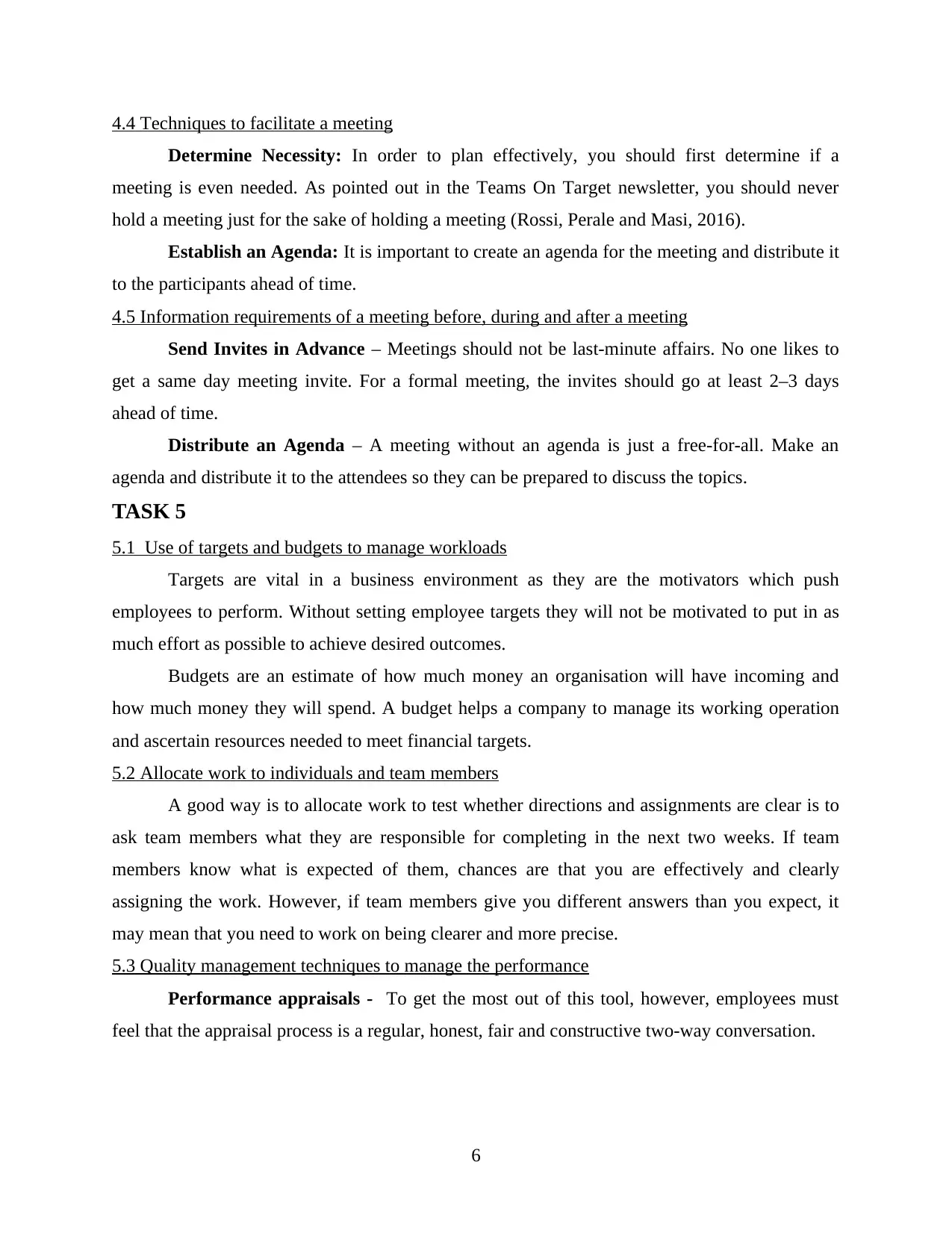
4.4 Techniques to facilitate a meeting
Determine Necessity: In order to plan effectively, you should first determine if a
meeting is even needed. As pointed out in the Teams On Target newsletter, you should never
hold a meeting just for the sake of holding a meeting (Rossi, Perale and Masi, 2016).
Establish an Agenda: It is important to create an agenda for the meeting and distribute it
to the participants ahead of time.
4.5 Information requirements of a meeting before, during and after a meeting
Send Invites in Advance – Meetings should not be last-minute affairs. No one likes to
get a same day meeting invite. For a formal meeting, the invites should go at least 2–3 days
ahead of time.
Distribute an Agenda – A meeting without an agenda is just a free-for-all. Make an
agenda and distribute it to the attendees so they can be prepared to discuss the topics.
TASK 5
5.1 Use of targets and budgets to manage workloads
Targets are vital in a business environment as they are the motivators which push
employees to perform. Without setting employee targets they will not be motivated to put in as
much effort as possible to achieve desired outcomes.
Budgets are an estimate of how much money an organisation will have incoming and
how much money they will spend. A budget helps a company to manage its working operation
and ascertain resources needed to meet financial targets.
5.2 Allocate work to individuals and team members
A good way is to allocate work to test whether directions and assignments are clear is to
ask team members what they are responsible for completing in the next two weeks. If team
members know what is expected of them, chances are that you are effectively and clearly
assigning the work. However, if team members give you different answers than you expect, it
may mean that you need to work on being clearer and more precise.
5.3 Quality management techniques to manage the performance
Performance appraisals - To get the most out of this tool, however, employees must
feel that the appraisal process is a regular, honest, fair and constructive two-way conversation.
6
Determine Necessity: In order to plan effectively, you should first determine if a
meeting is even needed. As pointed out in the Teams On Target newsletter, you should never
hold a meeting just for the sake of holding a meeting (Rossi, Perale and Masi, 2016).
Establish an Agenda: It is important to create an agenda for the meeting and distribute it
to the participants ahead of time.
4.5 Information requirements of a meeting before, during and after a meeting
Send Invites in Advance – Meetings should not be last-minute affairs. No one likes to
get a same day meeting invite. For a formal meeting, the invites should go at least 2–3 days
ahead of time.
Distribute an Agenda – A meeting without an agenda is just a free-for-all. Make an
agenda and distribute it to the attendees so they can be prepared to discuss the topics.
TASK 5
5.1 Use of targets and budgets to manage workloads
Targets are vital in a business environment as they are the motivators which push
employees to perform. Without setting employee targets they will not be motivated to put in as
much effort as possible to achieve desired outcomes.
Budgets are an estimate of how much money an organisation will have incoming and
how much money they will spend. A budget helps a company to manage its working operation
and ascertain resources needed to meet financial targets.
5.2 Allocate work to individuals and team members
A good way is to allocate work to test whether directions and assignments are clear is to
ask team members what they are responsible for completing in the next two weeks. If team
members know what is expected of them, chances are that you are effectively and clearly
assigning the work. However, if team members give you different answers than you expect, it
may mean that you need to work on being clearer and more precise.
5.3 Quality management techniques to manage the performance
Performance appraisals - To get the most out of this tool, however, employees must
feel that the appraisal process is a regular, honest, fair and constructive two-way conversation.
6
⊘ This is a preview!⊘
Do you want full access?
Subscribe today to unlock all pages.

Trusted by 1+ million students worldwide
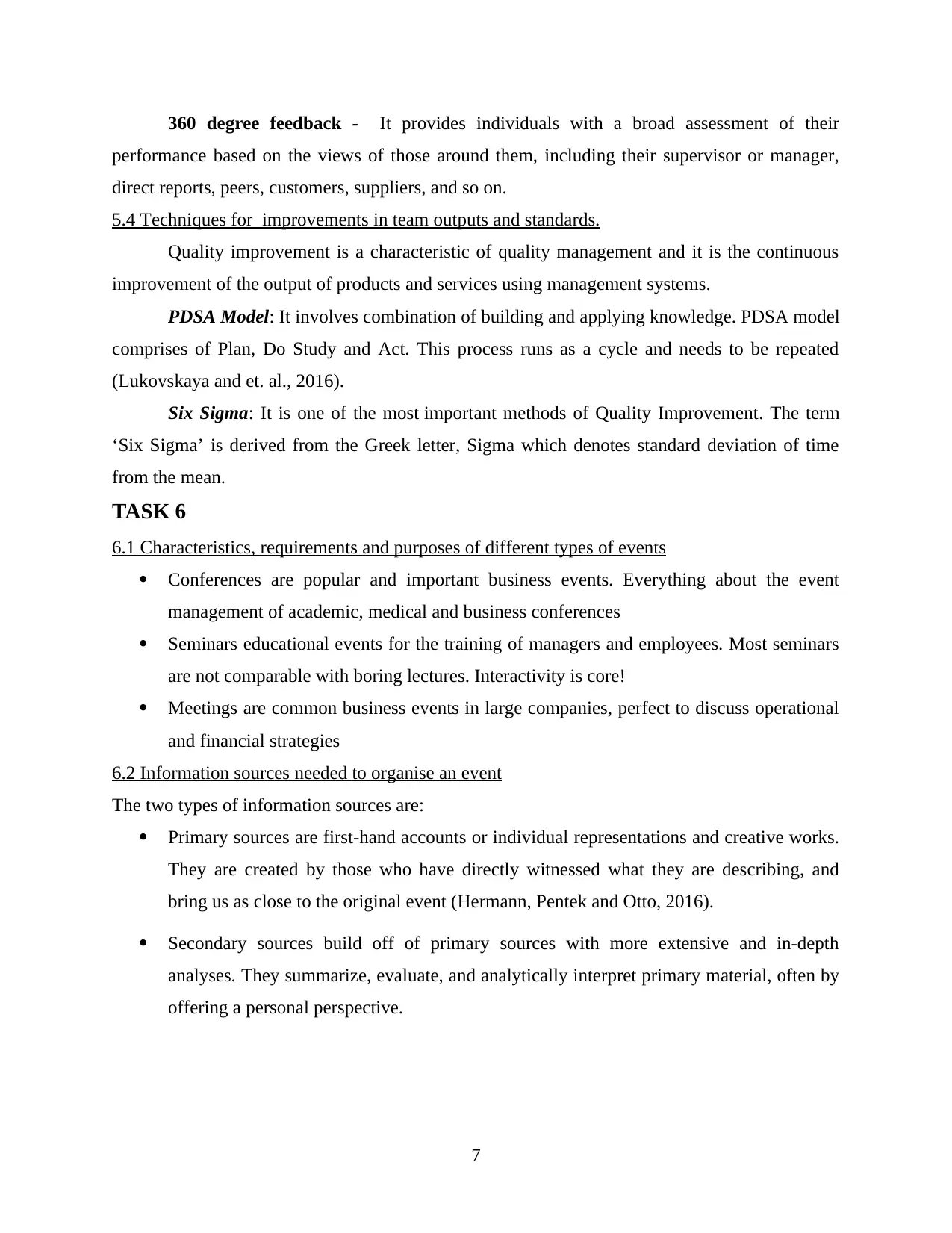
360 degree feedback - It provides individuals with a broad assessment of their
performance based on the views of those around them, including their supervisor or manager,
direct reports, peers, customers, suppliers, and so on.
5.4 Techniques for improvements in team outputs and standards.
Quality improvement is a characteristic of quality management and it is the continuous
improvement of the output of products and services using management systems.
PDSA Model: It involves combination of building and applying knowledge. PDSA model
comprises of Plan, Do Study and Act. This process runs as a cycle and needs to be repeated
(Lukovskaya and et. al., 2016).
Six Sigma: It is one of the most important methods of Quality Improvement. The term
‘Six Sigma’ is derived from the Greek letter, Sigma which denotes standard deviation of time
from the mean.
TASK 6
6.1 Characteristics, requirements and purposes of different types of events
Conferences are popular and important business events. Everything about the event
management of academic, medical and business conferences
Seminars educational events for the training of managers and employees. Most seminars
are not comparable with boring lectures. Interactivity is core!
Meetings are common business events in large companies, perfect to discuss operational
and financial strategies
6.2 Information sources needed to organise an event
The two types of information sources are:
Primary sources are first-hand accounts or individual representations and creative works.
They are created by those who have directly witnessed what they are describing, and
bring us as close to the original event (Hermann, Pentek and Otto, 2016).
Secondary sources build off of primary sources with more extensive and in-depth
analyses. They summarize, evaluate, and analytically interpret primary material, often by
offering a personal perspective.
7
performance based on the views of those around them, including their supervisor or manager,
direct reports, peers, customers, suppliers, and so on.
5.4 Techniques for improvements in team outputs and standards.
Quality improvement is a characteristic of quality management and it is the continuous
improvement of the output of products and services using management systems.
PDSA Model: It involves combination of building and applying knowledge. PDSA model
comprises of Plan, Do Study and Act. This process runs as a cycle and needs to be repeated
(Lukovskaya and et. al., 2016).
Six Sigma: It is one of the most important methods of Quality Improvement. The term
‘Six Sigma’ is derived from the Greek letter, Sigma which denotes standard deviation of time
from the mean.
TASK 6
6.1 Characteristics, requirements and purposes of different types of events
Conferences are popular and important business events. Everything about the event
management of academic, medical and business conferences
Seminars educational events for the training of managers and employees. Most seminars
are not comparable with boring lectures. Interactivity is core!
Meetings are common business events in large companies, perfect to discuss operational
and financial strategies
6.2 Information sources needed to organise an event
The two types of information sources are:
Primary sources are first-hand accounts or individual representations and creative works.
They are created by those who have directly witnessed what they are describing, and
bring us as close to the original event (Hermann, Pentek and Otto, 2016).
Secondary sources build off of primary sources with more extensive and in-depth
analyses. They summarize, evaluate, and analytically interpret primary material, often by
offering a personal perspective.
7
Paraphrase This Document
Need a fresh take? Get an instant paraphrase of this document with our AI Paraphraser
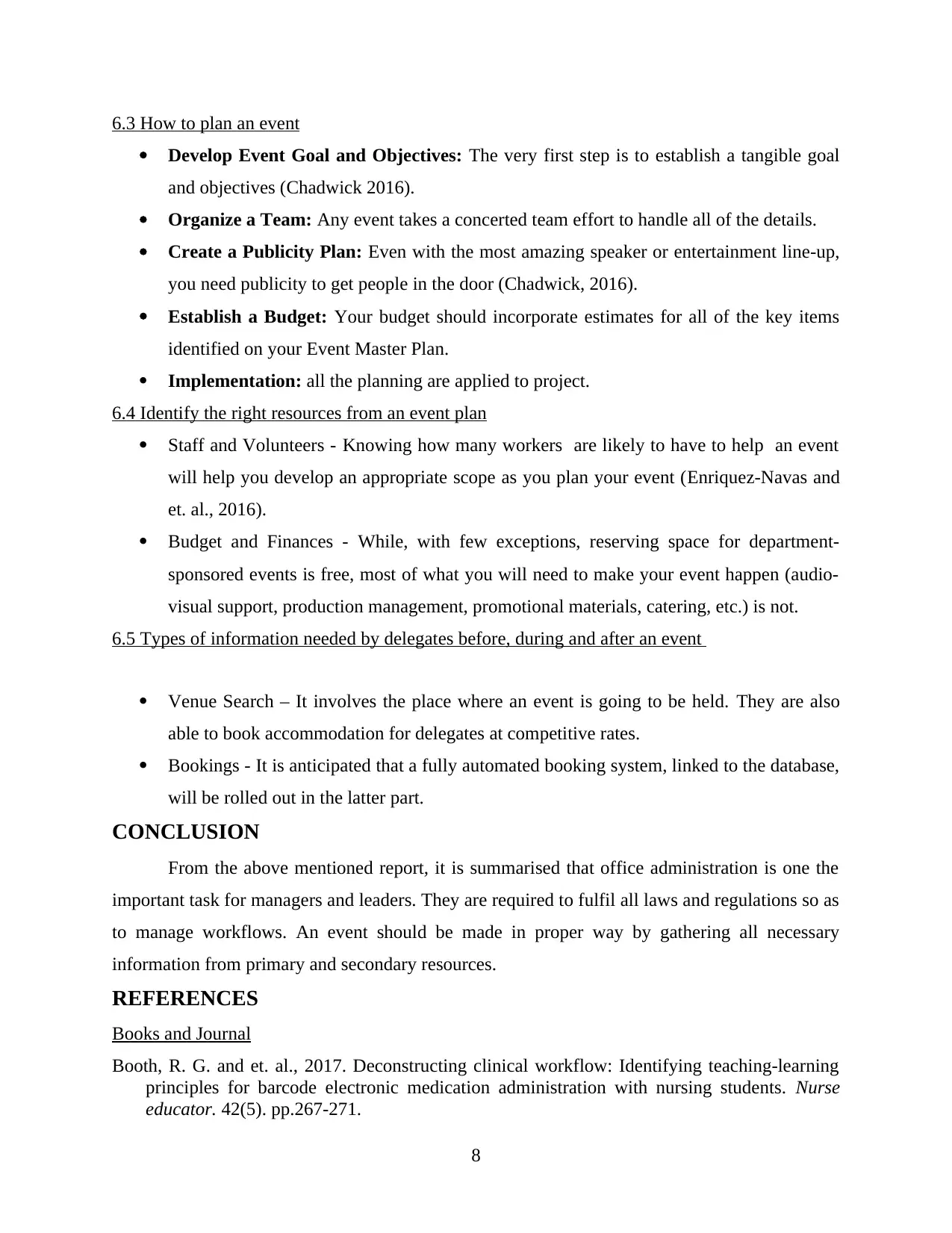
6.3 How to plan an event
Develop Event Goal and Objectives: The very first step is to establish a tangible goal
and objectives (Chadwick 2016).
Organize a Team: Any event takes a concerted team effort to handle all of the details.
Create a Publicity Plan: Even with the most amazing speaker or entertainment line-up,
you need publicity to get people in the door (Chadwick, 2016).
Establish a Budget: Your budget should incorporate estimates for all of the key items
identified on your Event Master Plan.
Implementation: all the planning are applied to project.
6.4 Identify the right resources from an event plan
Staff and Volunteers - Knowing how many workers are likely to have to help an event
will help you develop an appropriate scope as you plan your event (Enriquez-Navas and
et. al., 2016).
Budget and Finances - While, with few exceptions, reserving space for department-
sponsored events is free, most of what you will need to make your event happen (audio-
visual support, production management, promotional materials, catering, etc.) is not.
6.5 Types of information needed by delegates before, during and after an event
Venue Search – It involves the place where an event is going to be held. They are also
able to book accommodation for delegates at competitive rates.
Bookings - It is anticipated that a fully automated booking system, linked to the database,
will be rolled out in the latter part.
CONCLUSION
From the above mentioned report, it is summarised that office administration is one the
important task for managers and leaders. They are required to fulfil all laws and regulations so as
to manage workflows. An event should be made in proper way by gathering all necessary
information from primary and secondary resources.
REFERENCES
Books and Journal
Booth, R. G. and et. al., 2017. Deconstructing clinical workflow: Identifying teaching-learning
principles for barcode electronic medication administration with nursing students. Nurse
educator. 42(5). pp.267-271.
8
Develop Event Goal and Objectives: The very first step is to establish a tangible goal
and objectives (Chadwick 2016).
Organize a Team: Any event takes a concerted team effort to handle all of the details.
Create a Publicity Plan: Even with the most amazing speaker or entertainment line-up,
you need publicity to get people in the door (Chadwick, 2016).
Establish a Budget: Your budget should incorporate estimates for all of the key items
identified on your Event Master Plan.
Implementation: all the planning are applied to project.
6.4 Identify the right resources from an event plan
Staff and Volunteers - Knowing how many workers are likely to have to help an event
will help you develop an appropriate scope as you plan your event (Enriquez-Navas and
et. al., 2016).
Budget and Finances - While, with few exceptions, reserving space for department-
sponsored events is free, most of what you will need to make your event happen (audio-
visual support, production management, promotional materials, catering, etc.) is not.
6.5 Types of information needed by delegates before, during and after an event
Venue Search – It involves the place where an event is going to be held. They are also
able to book accommodation for delegates at competitive rates.
Bookings - It is anticipated that a fully automated booking system, linked to the database,
will be rolled out in the latter part.
CONCLUSION
From the above mentioned report, it is summarised that office administration is one the
important task for managers and leaders. They are required to fulfil all laws and regulations so as
to manage workflows. An event should be made in proper way by gathering all necessary
information from primary and secondary resources.
REFERENCES
Books and Journal
Booth, R. G. and et. al., 2017. Deconstructing clinical workflow: Identifying teaching-learning
principles for barcode electronic medication administration with nursing students. Nurse
educator. 42(5). pp.267-271.
8
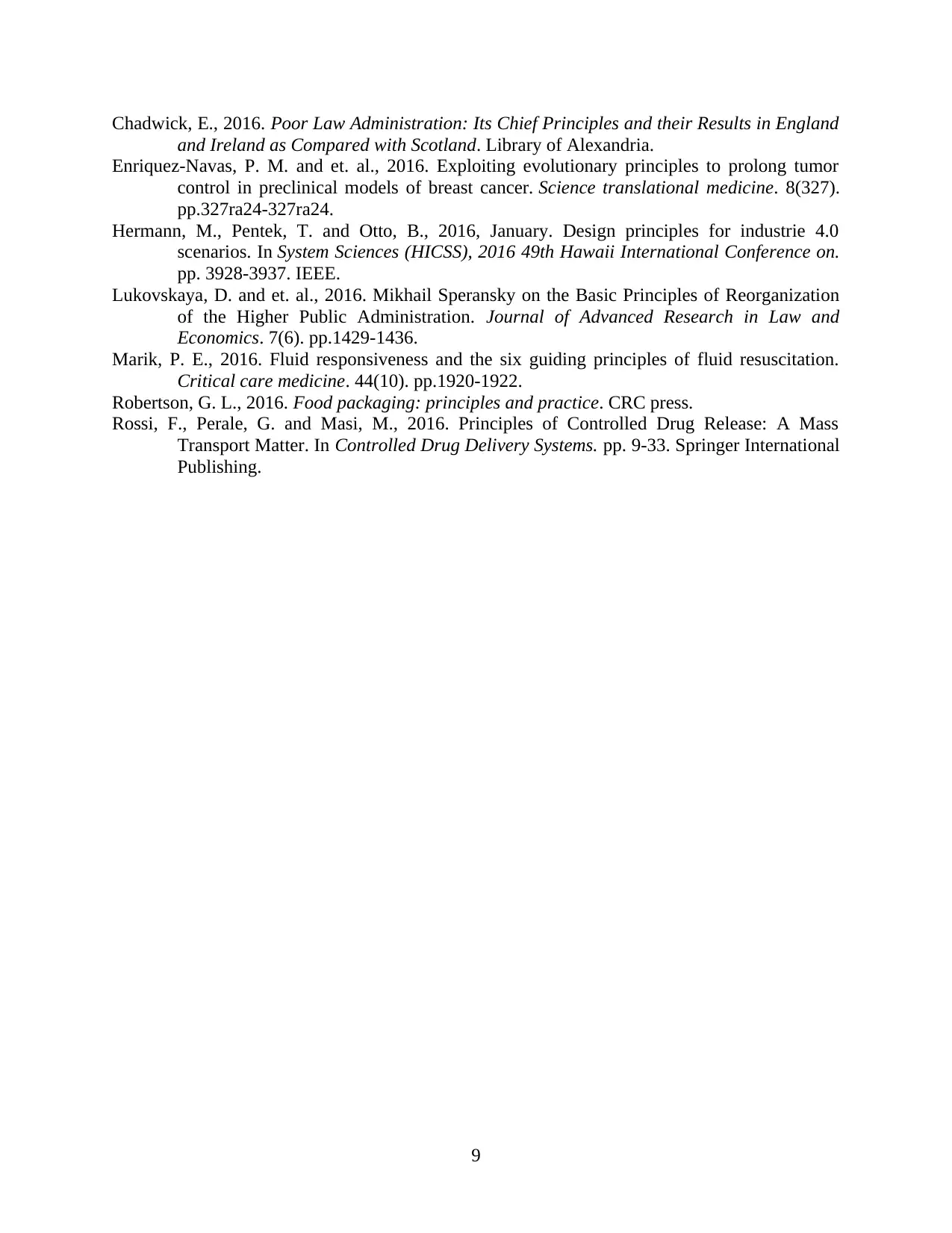
Chadwick, E., 2016. Poor Law Administration: Its Chief Principles and their Results in England
and Ireland as Compared with Scotland. Library of Alexandria.
Enriquez-Navas, P. M. and et. al., 2016. Exploiting evolutionary principles to prolong tumor
control in preclinical models of breast cancer. Science translational medicine. 8(327).
pp.327ra24-327ra24.
Hermann, M., Pentek, T. and Otto, B., 2016, January. Design principles for industrie 4.0
scenarios. In System Sciences (HICSS), 2016 49th Hawaii International Conference on.
pp. 3928-3937. IEEE.
Lukovskaya, D. and et. al., 2016. Mikhail Speransky on the Basic Principles of Reorganization
of the Higher Public Administration. Journal of Advanced Research in Law and
Economics. 7(6). pp.1429-1436.
Marik, P. E., 2016. Fluid responsiveness and the six guiding principles of fluid resuscitation.
Critical care medicine. 44(10). pp.1920-1922.
Robertson, G. L., 2016. Food packaging: principles and practice. CRC press.
Rossi, F., Perale, G. and Masi, M., 2016. Principles of Controlled Drug Release: A Mass
Transport Matter. In Controlled Drug Delivery Systems. pp. 9-33. Springer International
Publishing.
9
and Ireland as Compared with Scotland. Library of Alexandria.
Enriquez-Navas, P. M. and et. al., 2016. Exploiting evolutionary principles to prolong tumor
control in preclinical models of breast cancer. Science translational medicine. 8(327).
pp.327ra24-327ra24.
Hermann, M., Pentek, T. and Otto, B., 2016, January. Design principles for industrie 4.0
scenarios. In System Sciences (HICSS), 2016 49th Hawaii International Conference on.
pp. 3928-3937. IEEE.
Lukovskaya, D. and et. al., 2016. Mikhail Speransky on the Basic Principles of Reorganization
of the Higher Public Administration. Journal of Advanced Research in Law and
Economics. 7(6). pp.1429-1436.
Marik, P. E., 2016. Fluid responsiveness and the six guiding principles of fluid resuscitation.
Critical care medicine. 44(10). pp.1920-1922.
Robertson, G. L., 2016. Food packaging: principles and practice. CRC press.
Rossi, F., Perale, G. and Masi, M., 2016. Principles of Controlled Drug Release: A Mass
Transport Matter. In Controlled Drug Delivery Systems. pp. 9-33. Springer International
Publishing.
9
⊘ This is a preview!⊘
Do you want full access?
Subscribe today to unlock all pages.

Trusted by 1+ million students worldwide
1 out of 12